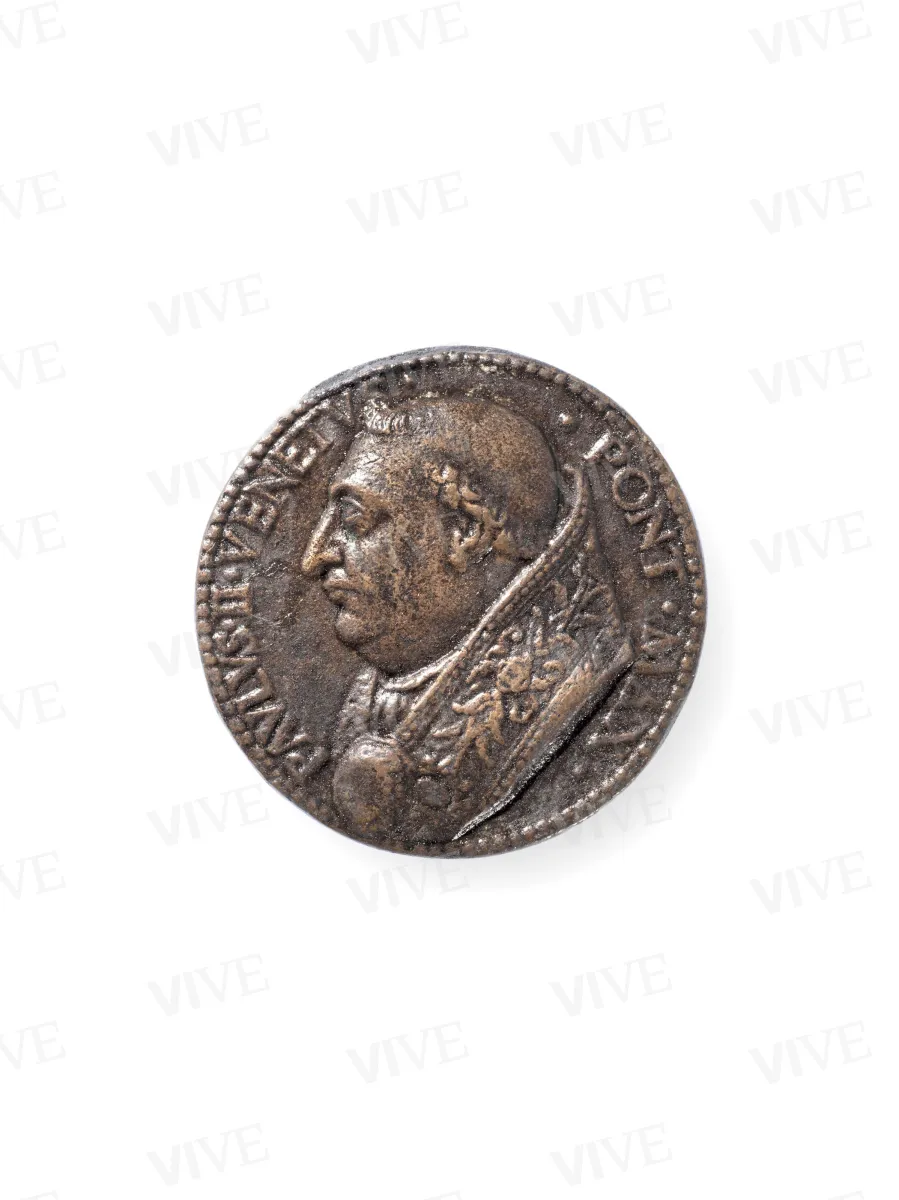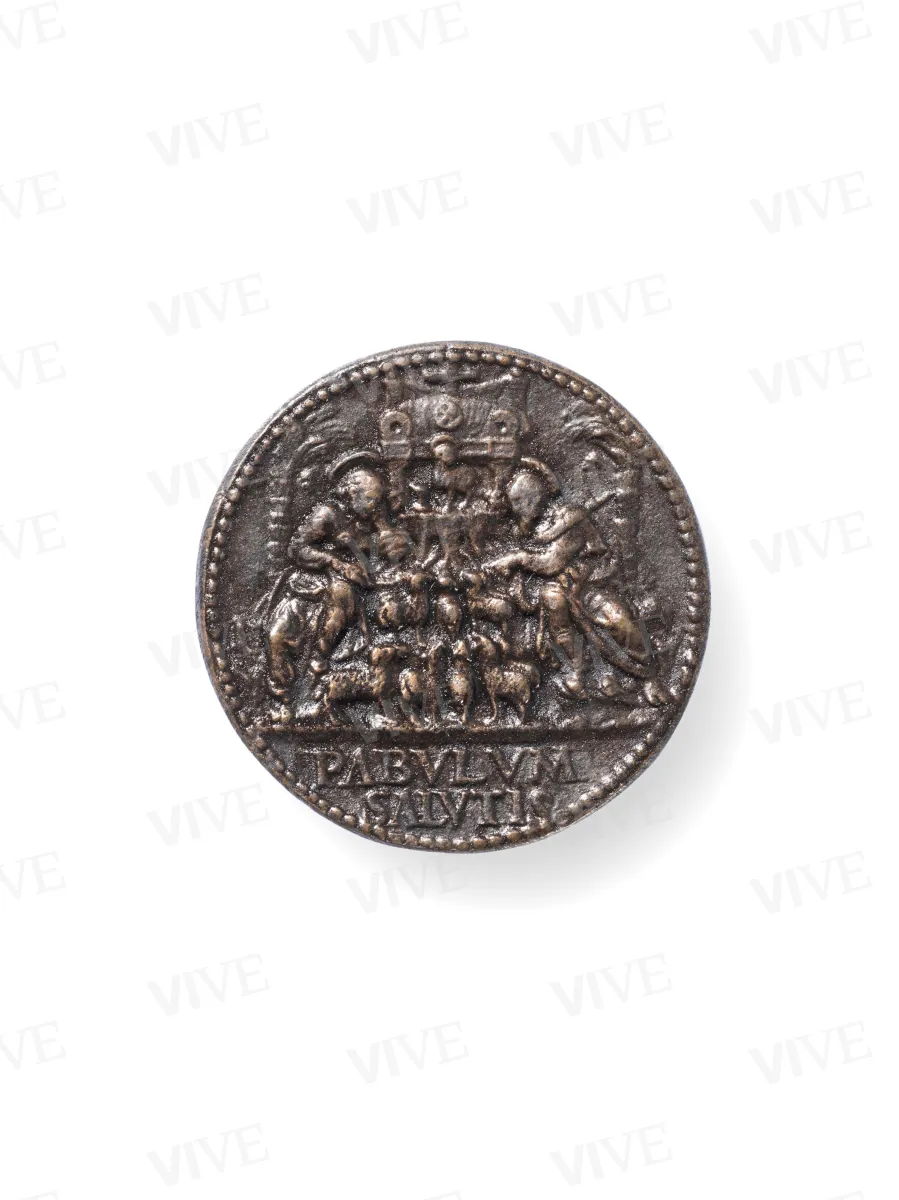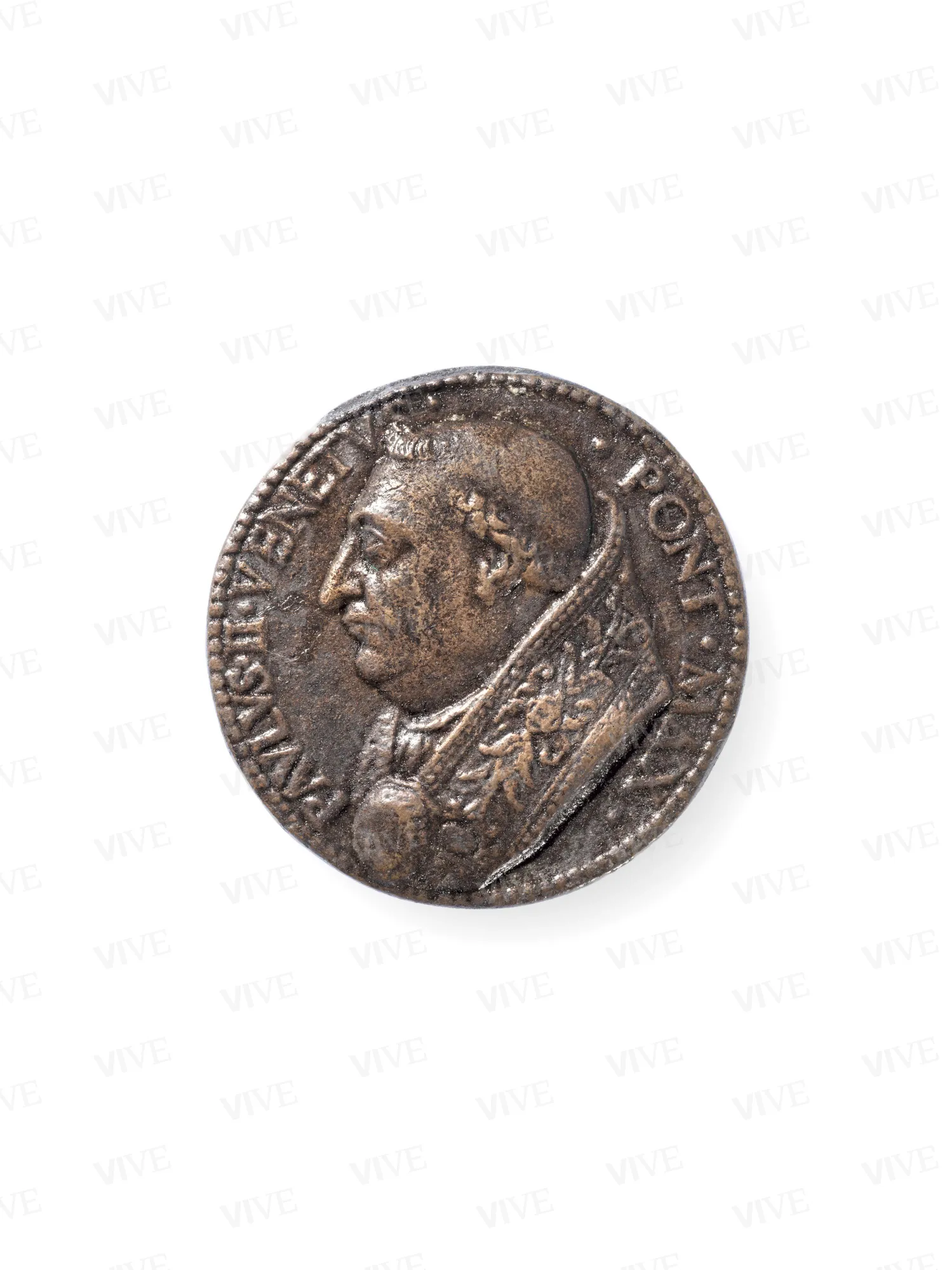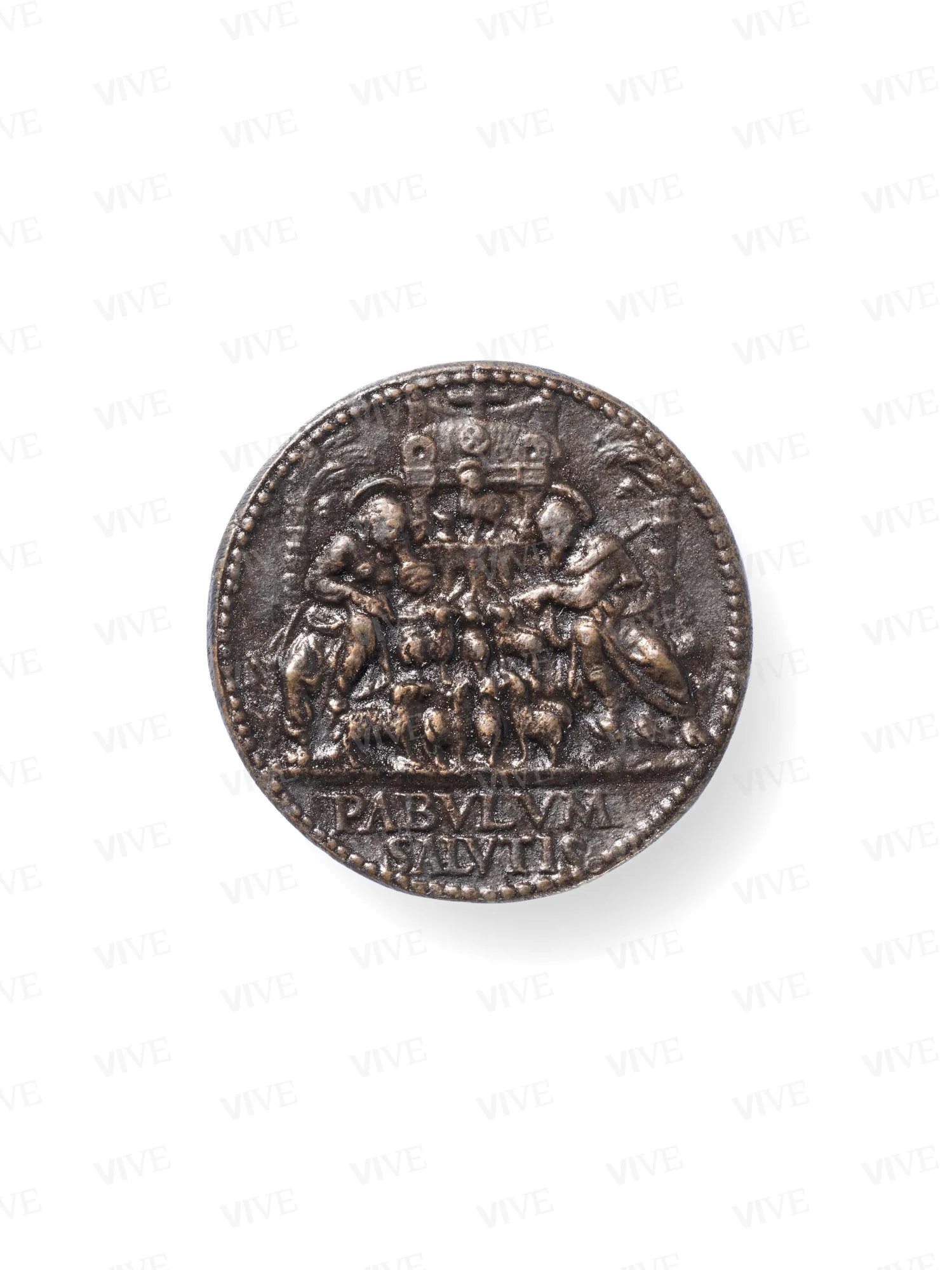Medal with Pope Paul II / Saints Peter and Paul at the source of faith
Cristoforo di Geremia 1469
This medal, crafted in 1469 by Cristoforo di Geremia of Mantua, commemorates the visit to Rome by a delegation of Maronites from Lebanon. This delegation was sent by Patriarch Peter of Antioch to discuss the principles of the Catholic religion. The intricate iconography on the reverse side of the medal symbolizes this event, depicting sheep (representing the Maronites) drinking from the spring waters of faith (the Roman Catholic Church).
This medal, crafted in 1469 by Cristoforo di Geremia of Mantua, commemorates the visit to Rome by a delegation of Maronites from Lebanon. This delegation was sent by Patriarch Peter of Antioch to discuss the principles of the Catholic religion. The intricate iconography on the reverse side of the medal symbolizes this event, depicting sheep (representing the Maronites) drinking from the spring waters of faith (the Roman Catholic Church).
Details of work
Catalog entry
The obverse of the medal features a left-facing bust of Pope Paul II, who served from 1464. He is depicted with a tonsure and wearing a cope adorned with pearls and plant motifs, fastened with a large oval gemmed button. On the reverse, there are Saints Peter and Paul standing beside a spring, flanked by two palm trees. At the top is a throne with a cross and the mystic Lamb, below which a flock of sheep can be seen drinking (Hill 1930, p. 199, n. 760; Modesti 2002, pp. 285–286, n. 105).
In comparison to other medals created in 1455 and 1465 (inv. 2948 and inv. 2995), this particular medal depicts a noticeably heavier pontiff with a distinctly swollen and soft chin. The physical stature of Pope Paul II is well documented through his portraits and various sources that describe him as having "a beautiful majesty of body [...] who in public always towered above others in stature, with a jovial, pleasant, and benign face." Bartolomeo Sacchi, also known as Platina, further noted that "he was very majestic in body, being exceptionally tall and well built" (Cannata 2011, pp. 15–16).
This medal features the pontiff as of 1469, two years before his death, commemorating a particular event depicted on the reverse side. In that year, a delegation of Maronites from Lebanon, dispatched by Patriarch Peter of Antioch, visited the Pope in Rome to discuss certain principles of the Catholic faith, as represented by the iconographic elements symbolising the pillars of faith. The cross, throne, and mystic Lamb convey the authority of the Catholic Church, while the rock with an emerging spring references the evangelical doctrine that nourishes the world under the guardianship of Peter and Paul, protectors of the Roman Catholic Apostolic Church. The sheep consuming this water represent the Maronites of Lebanon (indicated by the palm trees in the background), thus reconnecting them with the true foundation of their faith, in communion with the Roman Church (Buonanni 1699, pp. 74–75). The image of the sheep facing the Agnus Dei is similarly found in the Byzantine mosaic apse of the basilica of San Marco at Palazzo Venezia, a site cherished by the pontiff and likely inspiring Cristoforo di Geremia in his design of the medal’s reverse (Weiss 1958, pp. 61–62).
Multiple medallions of this type were discovered in 1911 within the palace foundations. Some of these medallions were subsequently moved to the collection of the Biblioteca Apostolica Vaticana, where they are currently preserved (Balbi De Caro 1971; Balbi De Caro 1973, p. 27).
Initially attributed to Bartolomeo Bellano of Padua, the medal was correctly reattributed to Cristoforo di Geremia by George Francis Hill as early as 1910. Hill identified similarities in the modeling of the figures and the creation of the lettering with some of Geremia's signed works (Hill 1910, pp. 364–366). The same artist is also associated with a different version of the obverse, which features panels with saints on the edge of the pope’s cope. This version is found both in combination with the reverse referring to the Maronites (Modesti 2002, pp. 287–288, n. 106), and with one depicting a papal audience (Museo di Palazzo Venezia, invv. 2933; 3160).
Cristoforo di Geremia, son of a goldsmith, was born in Mantua around 1410. He relocated to Rome in 1456 and initially served Cardinal Ludovico Scarampi Mezzarota before working for Ludovico Gonzaga. From 1465, he worked for Pope Paul II, creating numerous medals and restoring the bronze statue of Marcus Aurelius during Emperor Frederick III's visit to Rome in 1468. Cristoforo di Geremia died in Rome in 1476 (Pirzio Biroli Stefanelli 1985).
Giulia Zaccariotto
Entry published on 27 March 2025
State of conservation
Good.
Inscriptions
Obverse: [within border, within beaded border] “PAVLVS • II • VENETVS • • PONT[ifex] • MAX[imus] •”;
Reverse: [within beaded border, in exergue] “• PABVLVM / SALVTIS.”
Provenance
Purchased from Scipione Buonfili, 1920
References
Buonanni Filippo, Numismata Pontificum Romanorum quae a tempore Martini V usque ad annum MDCXCIX vel authoritate publica, vel privato genio in lucem prodiere, Romae 1699;
Hill George Francis, The Medals of Paul II, in «Numismatic Chronicle», s. 4, X, 1910, pp. 340-369;
Hill George Francis, A Corpus of Italian Medals of the Renaissance before Cellini, 2 voll., London 1930;
Weiss Roberto, Un umanista veneziano. Papa Paolo II, Venezia 1958;
Balbi De Caro Silvana, Le medaglie del Museo del Palazzo di Venezia in Roma, in «Medaglia», I, 1971, 2, pp. 7-15;
Balbi De Caro Silvana, Di alcune medaglie di Paolo II rinvenute nelle mura del Palazzo di Venezia in Roma, in «Medaglia», III, 1973, 5, pp. 24-34;
Pirzio Biroli Stefanelli Lucia, Cristoforo di Geremia, ad vocem, in Dizionario Biografico degli Italiani, XXXI, Roma 1985;
Modesti Adolfo, Corpus numismatum omnium Romanorum Pontificum. I. Da San Pietro (42-67) a Adriano VI (1522-1523), Roma 2002;
Cannata Pietro, Cultura e nostalgia dell’antico: collezioni e raccolte di bronzi al Palazzo di Venezia, in Cannata Pietro (a cura di), Museo Nazionale del Palazzo di Venezia. Sculture in bronzo, Roma 2011, pp. 15-30.














